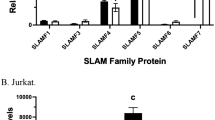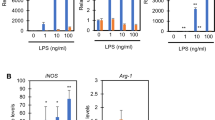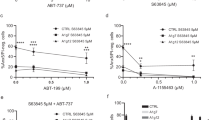Abstract
Human promonocytic cell line U937 cells can be induced to differentiate into macrophages by treatment with 12-O-tetradecanoylphorbol-13-acetate (TPA). TPA treatment induced the expression of the monocytic differentiation markers CD11b and CD36, with concomitant morphological changes. Moreover, TPA enhanced reactive oxygen species (ROS) generation in these cells, and phagocytic ability was also stimulated during differentiation. The antioxidant agent N-acetyl-L-cysteine inhibited the TPA-induced differentiation of U937 cells. TPA treatment decreased the expression level of catalase, which catalyzes the decomposition of hydrogen peroxide (H2O2) to H2O and O2. In contrast, TPA increased the level of manganese superoxide dismutase, which catalyzes the dismutation of superoxide into H2O2 and O2 without affecting the levels of copper-zinc superoxide dismutase or glutathione peroxidase 1, which removes H2O2 using glutathione as substrate. Treatment of U937 cells with catalase inhibited the enhancement of ROS generation induced by TPA, and blocked the TPA-induced differentiation of U937 cells. Human promyelocytic cell line HL60 cells were also induced to differentiate into macrophages by TPA. However, HP100-1 cells, its variant cell line overexpressing catalase, were resistant to TPA-induced differentiation. Our results suggest that catalase inhibits monocytic differentiation by TPA; the decrease in catalase level and the accumulation of H2O2 are significant events for monocyte/macrophage differentiation by TPA.
This is a preview of subscription content, access via your institution
Access options
Subscribe to this journal
Receive 12 print issues and online access
$259.00 per year
only $21.58 per issue
Buy this article
- Purchase on SpringerLink
- Instant access to full article PDF
Prices may be subject to local taxes which are calculated during checkout




Similar content being viewed by others
References
Orkin SH, Zon LI . Hematopoiesis: an evolving paradigm for stem cell biology. Cell 2008; 132: 631–644.
Auwerx J . The human leukemia cell line, THP-1: a multifacetted model for the study of monocyte-macrophage differentiation. Experientia 1991; 47: 22–31.
Gordon S, Taylor PR . Monocyte and macrophage heterogeneity. Nat Rev Immunol 2005; 5: 953–964.
Ziegler-Heitbrock HW . The biology of the monocyte system. Eur J Cell Biol 1989; 49: 1–12.
Jawien J . New insights into immunological aspects of atherosclerosis. Pol Arch Med Wewn 2008; 118: 127–131.
Forman HJ, Torres M . Reactive oxygen species and cell signaling: respiratory burst in macrophage signaling. Am J Respir Crit Care Med 2002; 166 (12 Part 2): S4–S8.
Babior BM . NADPH oxidase: an update. Blood 1999; 93: 1464–1476.
Ichikawa H, Kokura S, Aw TY . Role of endothelial mitochondria in oxidant production and modulation of neutrophil adherence. J Vasc Res 2004; 41: 432–444.
Finkel T . Signal transduction by reactive oxygen species in non-phagocytic cells. J Leukoc Biol 1999; 65: 337–340.
Irani K . Oxidant signaling in vascular cell growth, death, and survival: a review of the roles of reactive oxygen species in smooth muscle and endothelial cell mitogenic and apoptotic signaling. Circ Res 2000; 87: 179–183.
Hachiya M, Akashi M . Catalase regulates cell growth in HL60 human promyelocytic cells: evidence for growth regulation by H(2)O(2). Radiat Res 2005; 163: 271–282.
Gupta R, Karpatkin S, Basch RS . Hematopoiesis and stem cell renewal in long-term bone marrow cultures containing catalase. Blood 2006; 107: 1837–1846.
Sattler M, Winkler T, Verma S, Byrne CH, Shrikhande G, Salgia R et al. Hematopoietic growth factors signal through the formation of reactive oxygen species. Blood 1999; 93: 2928–2935.
Tibbles LA, Woodgett JR . The stress-activated protein kinase pathways. Cell Mol Life Sci 1999; 55: 1230–1254.
Carter AB, Tephly LA, Venkataraman S, Oberley LW, Zhang Y, Buettner GR et al. High levels of catalase and glutathione peroxidase activity dampen H2O2 signaling in human alveolar macrophages. Am J Respir Cell Mol Biol 2004; 31: 43–53.
Flaherty DM, Monick MM, Hinde SL . Human alveolar macrophages are deficient in PTEN. The role of endogenous oxidants. J Biol Chem 2006; 281: 5058–5064.
Clempus RE, Griendling KK . Reactive oxygen species signaling in vascular smooth muscle cells. Cardiovasc Res 2006; 71: 216–225.
Sauer H, Wartenberg M, Hescheler J . Reactive oxygen species as intracellular messengers during cell growth and differentiation. Cell Physiol Biochem 2001; 11: 173–186.
Koeffler HP . Induction of differentiation of human acute myelogenous leukemia cells: therapeutic implications. Blood 1983; 62: 709–721.
Uchida T, Kanno T, Hosaka S . Direct measurement of phagosomal reactive oxygen by luminol-binding microspheres. J Immunol Methods 1985; 77: 55–61.
Takada Y, Hachiya M, Park SH, Osawa Y, Ozawa T, Akashi M . Role of reactive oxygen species in cells overexpressing manganese superoxide dismutase: mechanism for induction of radioresistance. Mol Cancer Res 2002; 1: 137–146.
Clemens MJ . Purification of Eukaryotic mRNA. In: Hames BD, Higgins SJ (eds). Transcription and Translation. A Practical Approach. IRL Press: Oxford, 1984, pp 211–220.
Gidlund M, Orn A, Pattengale PK, Jansson M, Wigzell H, Nilsson K . Natural killer cells kill tumour cells at a given stage of differentiation. Nature 1981; 292: 848–850.
Farokhzad OC, Shelley CS, Arnaout MA . Induction of the CD11b gene during activation of the monocytic cell line U937 requires a novel nuclear factor MS-2. J Immunol 1996; 157: 5597–5605.
Puig-Kroger A, Dominguez-Soto A, Martinez-Munoz L, Serrano-Gomez D, Lopez-Bravo M, Sierra-Filardi E et al. RUNX3 negatively regulates CD36 expression in myeloid cell lines. J Immunol 2006; 177: 2107–2114.
Febbraio M, Hajjar DP, Silverstein RL . CD36: a class B scavenger receptor involved in angiogenesis, atherosclerosis, inflammation, and lipid metabolism. J Clin Invest 2001; 108: 785–791.
Finstad HS, Drevon CA, Kulseth MA, Synstad AV, Knudsen E, Kolset SO . Cell proliferation, apoptosis and accumulation of lipid droplets in U937-1 cells incubated with eicosapentaenoic acid. Biochem J 1998; 336 (Part 2): 451–459.
Alessio M, De Monte L, Scirea A, Gruarin P, Tandon NN, Sitia R . Synthesis, processing, and intracellular transport of CD36 during monocytic differentiation. J Biol Chem 1996; 271: 1770–1775.
Greenwalt DE, Lipsky RH, Ockenhouse CF, Ikeda H, Tandon NN, Jamieson GA . Membrane glycoprotein CD36: a review of its roles in adherence, signal transduction, and transfusion medicine. Blood 1992; 80: 1105–1115.
Stendahl O, Dahlgren C, Hed J . Physicochemical and functional changes in human leukemic cell line HL-60. J Cell Physiol 1982; 112: 217–221.
Rovera G, Santoli D, Damsky C . Human promyelocytic leukemia cells in culture differentiate into macrophage-like cells when treated with a phorbol diester. Proc Natl Acad Sci USA 1979; 76: 2779–2783.
Schreck R, Baeuerle PA . A role for oxygen radicals as second messengers. Trends Cell Biol 1991; 1: 39–42.
Hass R, Hirano M, Kharbanda S, Rubin E, Meinhardt G, Kufe D . Resistance to phorbol ester-induced differentiation of a U-937 myeloid leukemia cell variant with a signaling defect upstream to Raf-1 kinase. Cell Growth Differ 1993; 4: 657–663.
Macfarlane DE, Manzel L . Activation of beta-isozyme of protein kinase C (PKC beta) is necessary and sufficient for phorbol ester-induced differentiation of HL-60 promyelocytes. Studies with PKC beta-defective PET mutant. J Biol Chem 1994; 269: 4327–4331.
Tonetti DA, Henning-Chubb C, Yamanishi DT, Huberman E . Protein kinase C-beta is required for macrophage differentiation of human HL-60 leukemia cells. J Biol Chem 1994; 269: 23230–23235.
Yang KD, Mizobuchi T, Kharbanda SM, Datta R, Huberman E, Kufe DW et al. All-trans retinoic acid reverses phorbol ester resistance in a human myeloid leukemia cell line. Blood 1994; 83: 490–496.
Barbieri SS, Eligini S, Brambilla M, Tremoli E, Colli S . Reactive oxygen species mediate cyclooxygenase-2 induction during monocyte to macrophage differentiation: critical role of NADPH oxidase. Cardiovasc Res 2003; 60: 187–197.
Kikuchi H, Fujinawa T, Kuribayashi F, Nakanishi A, Imajoh-Ohmi S, Goto M et al. Induction of essential components of the superoxide generating system in human monoblastic leukemia U937 cells. J Biochem 1994; 116: 742–746.
Levy R, Rotrosen D, Nagauker O, Leto TL, Malech HL . Induction of the respiratory burst in HL-60 cells. Correlation of function and protein expression. J Immunol 1990; 145: 2595–2601.
Yang KD, Shaio MF . Hydroxyl radicals as an early signal involved in phorbol ester-induced monocytic differentiation of HL60 cells. Biochem Biophys Res Commun 1994; 200: 1650–1657.
Datta R, Yoshinaga K, Kaneki M, Pandey P, Kufe D . Phorbol ester-induced generation of reactive oxygen species is protein kinase cbeta -dependent and required for SAPK activation. J Biol Chem 2000; 275: 41000–41003.
Traore K, Trush MA, George Jr M, Spannhake EW, Anderson W, Asseffa A . Signal transduction of phorbol 12-myristate 13-acetate (PMA)-induced growth inhibition of human monocytic leukemia THP-1 cells is reactive oxygen dependent. Leuk Res 2005; 29: 863–879.
Andrew PW, Robertson AK, Lowrie DB, Cross AR, Jones OT . Induction of synthesis of components of the hydrogen peroxide-generating oxidase during activation of the human monocytic cell line U937 by interferon-gamma. Biochem J 1987; 248: 281–283.
Capeillere-Blandin C, Masson A, Descamps-Latscha B . Molecular characteristics of cytochrome b558 isolated from human granulocytes, monocytes and HL60 and U937 cells differentiated into monocyte/macrophages. Biochim Biophys Acta 1991; 1094: 55–65.
Newburger PE, Ezekowitz RA, Whitney C, Wright J, Orkin SH . Induction of phagocyte cytochrome b heavy chain gene expression by interferon gamma. Proc Natl Acad Sci USA 1988; 85: 5215–5219.
Speier C, Newburger PE . Changes in superoxide dismutase, catalase, and the glutathione cycle during induced myeloid differentiation. Arch Biochem Biophys 1986; 251: 551–557.
Auwerx JH, Chait A, Wolfbauer G, Deeb SS . Loss of copper-zinc superoxide dismutase gene expression in differentiated cells of myelo-monocytic origin. Blood 1989; 74: 1807–1810.
Oberley LW, Ridnour LA, Sierra-Rivera E, Oberley TD, Guernsey DL . Superoxide dismutase activities of differentiating clones from an immortal cell line. J Cell Physiol 1989; 138: 50–60.
Kang HK, Suh JH, Lee JJ, Yoon SH, Hyun JW, Choi SW et al. Induction of the differentiation of HL-60 promyelocytic leukemia cells by L-ascorbic acid. Free Radic Res 2003; 37: 773–779.
Nakagawara A, Nathan CF, Cohn ZA . Hydrogen peroxide metabolism in human monocytes during differentiation in vitro. J Clin Invest 1981; 68: 1243–1252.
Kasugai I, Yamada M . Adaptation of human leukemia HL-60 cells to hydrogen peroxide as oxidative stress. Leuk Res 1989; 13: 757–762.
Preston TJ, Muller WJ, Singh G . Scavenging of extracellular H2O2 by catalase inhibits the proliferation of HER-2/Neu-transformed rat-1 fibroblasts through the induction of a stress response. J Biol Chem 2001; 276: 9558–9564.
Gutteridge J, Halliwell B . Free Radicals in Biology and Medicine. Clarendon Press: Oxford, 1999.
Sundaresan M, Yu ZX, Ferrans VJ, Irani K, Finkel T . Requirement for generation of H2O2 for platelet-derived growth factor signal transduction. Science 1995; 270: 296–299.
Nishihira J, Ishibashi T, Takeichi N, Sakamoto W, Nakamura M . A role for oxygen radicals in rat monocytic leukemia cell differentiation under stimulation with platelet-activating factor. Biochim Biophys Acta 1994; 1220: 286–290.
Lee NK, Choi YG, Baik JY, Han SY, Jeong DW, Bae YS et al. A crucial role for reactive oxygen species in RANKL-induced osteoclast differentiation. Blood 2005; 106: 852–859.
Danilenko M, Wang Q, Wang X, Levy J, Sharoni Y, Studzinski GP . Carnosic acid potentiates the antioxidant and prodifferentiation effects of 1alpha,25-dihydroxyvitamin D3 in leukemia cells but does not promote elevation of basal levels of intracellular calcium. Cancer Res 2003; 63: 1325–1332.
Esposito F, Agosti V, Morrone G, Morra F, Cuomo C, Russo T et al. Inhibition of the differentiation of human myeloid cell lines by redox changes induced through glutathione depletion. Biochem J 1994; 301 (Part 3): 649–653.
Wang Q, Salman H, Danilenko M, Studzinski GP . Cooperation between antioxidants and 1,25-dihydroxyvitamin D3 in induction of leukemia HL60 cell differentiation through the JNK/AP-1/Egr-1 pathway. J Cell Physiol 2005; 204: 964–974.
Nenoi M, Ichimura S, Mita K, Yukawa O, Cartwright IL . Regulation of the catalase gene promoter by Sp1, CCAAT-recognizing factors, and a WT1/Egr-related factor in hydrogen peroxide-resistant HP100 cells. Cancer Res 2001; 61: 5885–5894.
Kharbanda S, Nakamura T, Stone R, Hass R, Bernstein S, Datta R et al. Expression of the early growth response 1 and 2 zinc finger genes during induction of monocytic differentiation. J Clin Invest 1991; 88: 571–577.
Nguyen HQ, Hoffman-Liebermann B, Liebermann DA . The zinc finger transcription factor Egr-1 is essential for and restricts differentiation along the macrophage lineage. Cell 1993; 72: 197–209.
Acknowledgements
This study was supported by a special grant for Radiation Emergency Medicine from the Ministry of Education, Culture, Sports, Science and Technology. We thank Ms Aki Yamamoto for her excellent secretarial support.
Author information
Authors and Affiliations
Corresponding author
Rights and permissions
About this article
Cite this article
Yamamoto, T., Sakaguchi, N., Hachiya, M. et al. Role of catalase in monocytic differentiation of U937 cells by TPA: hydrogen peroxide as a second messenger. Leukemia 23, 761–769 (2009). https://doi.org/10.1038/leu.2008.353
Received:
Revised:
Accepted:
Published:
Issue Date:
DOI: https://doi.org/10.1038/leu.2008.353
Keywords
This article is cited by
-
Cellular lensing and near infrared fluorescent nanosensor arrays to enable chemical efflux cytometry
Nature Communications (2021)
-
CD36 in chronic kidney disease: novel insights and therapeutic opportunities
Nature Reviews Nephrology (2017)
-
The inhibitory effect of troglitazone on macrophage differentiation mediated by repressing NF-κB ctivation independently of PPARγ
Molecular & Cellular Toxicology (2014)
-
Hydrogen peroxide (H2O2) induces leukemic but not normal hematopoietic cell death in a dose-dependent manner
Cancer Cell International (2013)
-
Toxicity of citrate-capped AuNPs: an in vitro and in vivo assessment
Journal of Nanoparticle Research (2011)



